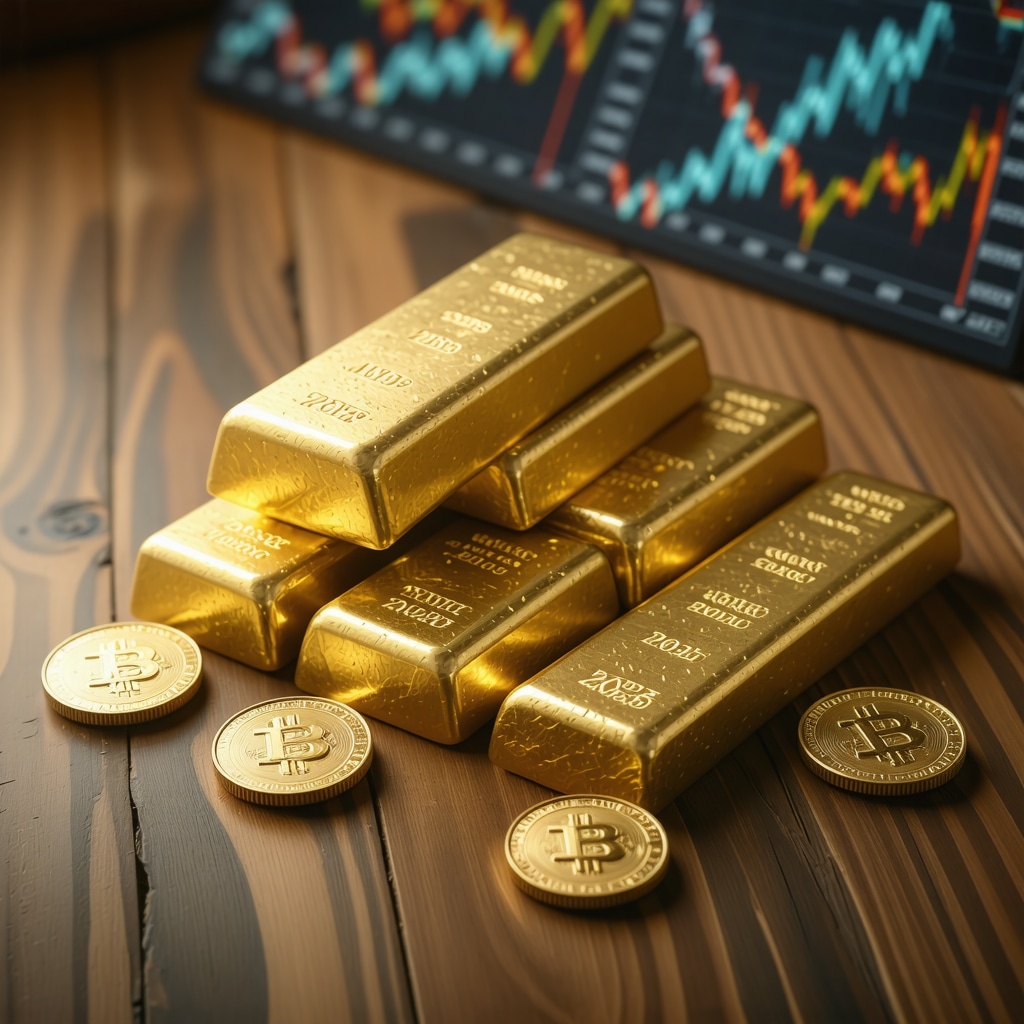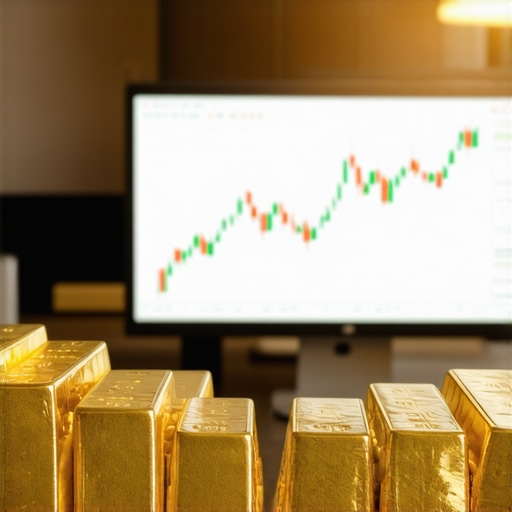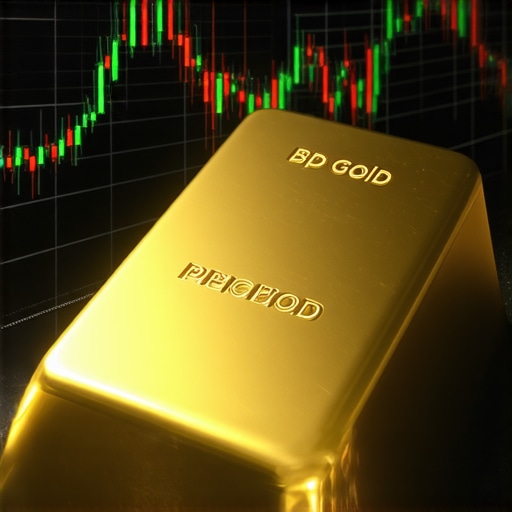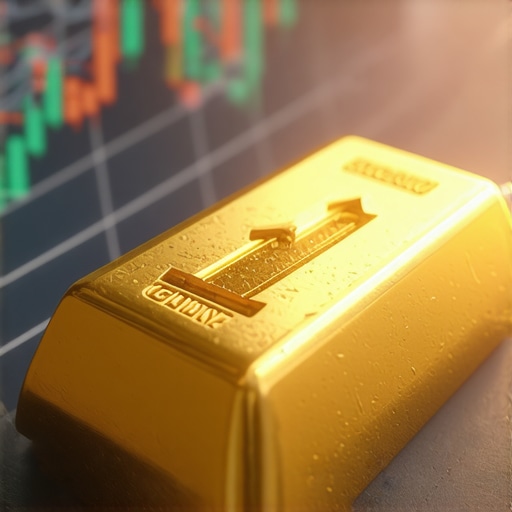Unlocking the Future: The Complex Dynamics Behind Gold Price Forecasts for 2025
In the ever-shifting landscape of global finance, predicting gold prices with precision remains a coveted skill for investors and analysts alike. As 2025 approaches, understanding the multifaceted influences shaping gold’s value is crucial for making informed decisions. From geopolitical tensions to inflationary pressures, gold’s role as a safe haven asset continues to evolve, demanding nuanced expertise beyond superficial market observations.
Decoding Macro-Economic Signals: How Inflation and Interest Rates Drive Gold Valuations
One cannot overstate the impact of inflation trends and central bank interest rate policies on gold prices. Historically, gold has served as a hedge against inflation — when currency values erode, investors flock to tangible assets like gold to preserve purchasing power. The Federal Reserve’s and other central banks’ maneuvers in 2025, particularly regarding interest rates, will likely create volatility in gold markets. For instance, if real interest rates remain negative, gold could see meaningful price gains as the opportunity cost of holding non-yielding bullion diminishes.
Global Gold Demand Shifts: Emerging Markets and Central Bank Purchases
Another pivotal driver in the gold price equation is the shifting demand landscape, especially from emerging economies and sovereign reserves. Countries like India and China continue to increase gold consumption culturally and as strategic reserves. Additionally, central banks’ gold purchasing programs—such as those tracked in authoritative reports on central bank gold purchases—offer critical insights into supply-demand balance. These purchases often signal confidence in gold’s stability amid global economic uncertainties, thereby influencing price trends.
Technological and Market Innovations Influencing Gold Investment Strategies
Beyond traditional factors, innovative financial instruments such as gold ETFs and mutual funds have transformed accessibility and liquidity for investors, impacting gold price momentum. The rise of algorithmic trading and advanced analytics enables market participants to respond swiftly to news and data, sometimes amplifying short-term price movements. Understanding these dynamics is essential for sophisticated investors aiming to leverage market inefficiencies in 2025.
How Can Investors Navigate Gold Price Volatility in 2025 for Optimal Returns?
Volatility is an inherent feature of gold markets, especially amid geopolitical unrest and economic shifts. Expert investors often employ diversified strategies combining physical gold holdings, ETFs, and mining stocks to balance risk and reward. Staying informed through rigorous analysis of key gold price factors for 2025 and monitoring macroeconomic indicators is indispensable. Moreover, coupling these insights with proven gold trading techniques can enhance portfolio resilience.
Are you intrigued by gold’s potential and want to deepen your investment knowledge? Explore related expert guides on why investing in gold makes sense in 2025 and discover how to integrate gold effectively into your portfolio.
For those interested in the foundational data behind these trends, the World Gold Council offers comprehensive analyses and forecasts, providing a trusted resource for investors seeking authoritative information (World Gold Council Research).
Integrating ESG Considerations: The New Frontier in Gold Investment
Environmental, Social, and Governance (ESG) factors have increasingly become integral to investment decision-making. Gold mining companies are under growing scrutiny regarding sustainable practices, ethical sourcing, and community impact. Investors aiming for long-term value are prioritizing gold stocks and funds that demonstrate robust ESG compliance. This trend influences gold prices indirectly, as companies with strong ESG credentials may attract premium valuations and benefit from enhanced investor confidence.
Moreover, ESG-focused gold ETFs and mutual funds offer avenues for conscientious investors to participate in the gold market while supporting sustainable mining initiatives. Understanding the ESG landscape in gold investment is not merely a moral imperative but a pragmatic strategy aligning with evolving market dynamics in 2025.
Currency Fluctuations and Their Complex Impact on Gold Prices
The relationship between gold prices and currency markets, especially the US dollar, remains a cornerstone of price analysis. Typically, a weaker dollar makes gold cheaper for holders of other currencies, boosting demand and prices. However, 2025 could see nuanced interactions as other major currencies undergo their own economic challenges and policy shifts.
For example, the eurozone’s monetary policies and emerging market currencies’ volatility will contribute to a complex mosaic of currency influences. Investors must analyze these interdependencies critically to anticipate gold price movements accurately. Currency hedging strategies might become essential tools in a gold-focused portfolio to mitigate risks stemming from exchange rate fluctuations.
What Role Will Technological Advances Play in Shaping Gold Market Accessibility and Pricing in 2025?
Technological innovations are revolutionizing how investors access and trade gold. Blockchain technology, for instance, facilitates more transparent and secure transactions in gold trading and ownership, reducing counterparty risks and enhancing liquidity. Digital gold tokens are emerging as novel investment vehicles, allowing fractional ownership and easier transferability.
These advancements democratize gold investment but also introduce regulatory and security considerations that investors must navigate. Staying abreast of technological trends and understanding their implications on market behavior is crucial for capitalizing on opportunities and managing risks in 2025.
Leveraging Data Analytics and AI in Gold Price Forecasting
Artificial intelligence and big data analytics are increasingly employed to decode complex market signals and forecast gold price trends with higher precision. By integrating vast datasets—ranging from macroeconomic indicators to social sentiment and geopolitical events—AI models can identify patterns that traditional analysis might overlook.
Investors leveraging these sophisticated tools gain a competitive edge, enabling dynamic portfolio adjustments responsive to real-time market shifts. However, reliance on AI requires critical assessment of algorithmic biases and data quality to avoid misleading conclusions.
Practical Implications for Portfolio Management: Balancing Gold with Other Asset Classes
In 2025, strategic asset allocation will emphasize the balance between gold and other investment categories such as equities, bonds, and real estate. Gold’s historical role as a hedge against inflation and market downturns complements growth-oriented assets, enhancing portfolio diversification.
Expert investors consider factors like volatility correlations, liquidity needs, and investment horizons when integrating gold. Tools like gold vs stocks analysis provide valuable frameworks for optimizing this balance.
To deepen your understanding of how to craft a resilient portfolio incorporating gold, explore our detailed guide on best gold investment strategies for 2025.
Harnessing Artificial Intelligence: The Frontier of Predictive Accuracy in Gold Markets
Artificial Intelligence (AI) and machine learning have transcended rudimentary forecasting, evolving into indispensable tools for navigating the labyrinthine gold market in 2025. Unlike traditional statistical models, AI algorithms integrate heterogeneous data streams — from macroeconomic indicators and geopolitical risk assessments to social media sentiment and real-time trading volumes — to generate nuanced, probabilistic forecasts. These models continuously refine themselves via reinforcement learning, adapting to emergent patterns that evade human analysts.
For example, deep neural networks can detect subtle correlations between seemingly unrelated variables, such as commodity price fluctuations in energy markets and their lagged effects on gold demand. This multidimensional approach enhances predictive precision, enabling institutional investors to preempt market inflections rather than react post hoc.
What Are the Limitations and Ethical Considerations of Relying on AI for Gold Price Predictions?
While AI offers unprecedented analytical capabilities, it is not immune to pitfalls. Algorithmic biases embedded in training data can skew predictions, especially if historical datasets inadequately represent rare geopolitical shocks or unprecedented monetary policies. Furthermore, overreliance on opaque “black-box” models may obscure the rationale behind forecasts, complicating risk management decisions.
Ethically, the democratization of AI-powered tools raises concerns about market manipulation and unequal access to advanced analytics, potentially exacerbating systemic risks. Investors must critically evaluate AI outputs and maintain human oversight to ensure balanced decision-making.
Integrating ESG Metrics: Redefining Gold’s Investment Appeal Amid Sustainability Demands
Environmental, Social, and Governance (ESG) metrics have evolved from niche considerations to central pillars shaping gold investment narratives. Sophisticated investors now incorporate ESG scorecards into valuation models, recognizing that compliance with stringent sustainability standards correlates with operational resilience and long-term profitability in gold mining enterprises.
For instance, mines employing innovative water recycling technologies and minimizing carbon footprints often command premium valuations due to lower regulatory risks and enhanced social license to operate. Conversely, entities implicated in unethical labor practices or environmental degradation face reputational hazards that can swiftly erode market confidence.
ESG-focused funds are increasingly influencing liquidity and capital flows in the gold sector, thereby indirectly steering price dynamics. Awareness of evolving ESG frameworks, such as the Task Force on Climate-related Financial Disclosures (TCFD) guidelines, is essential for discerning investors wanting to align portfolios with global sustainability imperatives.
Currency Interplays Beyond the US Dollar: Navigating a Multipolar Monetary Landscape
While the US dollar remains the dominant currency influencing gold prices, 2025 is poised to witness a more intricate interplay among multiple currencies. The euro’s fluctuating trajectory amid divergent fiscal policies in the Eurozone, the Chinese yuan’s gradual internationalization, and emerging market currencies’ volatility collectively add layers of complexity to gold valuation.
For example, a strengthening yuan driven by China’s strategic gold accumulation could exert upward pressure on global gold prices despite dollar appreciation. Similarly, geopolitical tensions affecting emerging market currencies may catalyze localized gold demand spikes, creating fragmented but impactful market forces.
Advanced currency hedging strategies leveraging derivatives and cross-currency swaps are increasingly indispensable to mitigate multifaceted exchange rate risks inherent in gold portfolios. Understanding this multipolar currency dynamic enables investors to anticipate asymmetric effects on gold prices and optimize hedging frameworks accordingly.
To explore how these sophisticated factors converge and influence gold price trajectories, continue engaging with our in-depth analyses and expert commentaries that dissect emerging trends shaping gold investment in 2025 and beyond.
Dynamic Risk Management: Sophisticated Hedging Techniques for Gold Investors
As gold markets in 2025 become increasingly sensitive to intertwined geopolitical and macroeconomic variables, advanced hedging techniques have emerged as essential tools for mitigating portfolio risks. Beyond conventional futures and options, strategies such as cross-asset hedging—leveraging correlations between gold and commodities like oil or currencies—offer nuanced protection against market swings. For example, deploying variance swaps or volatility derivatives allows investors to hedge against abrupt price spikes triggered by unforeseen crises, thereby preserving portfolio integrity.
Harnessing Behavioral Finance Insights: Decoding Investor Sentiment’s Role in Gold Price Fluctuations
Understanding the psychological drivers behind gold market movements is a frontier that sophisticated analysts increasingly prioritize. Behavioral finance models highlight how herd behavior, risk aversion shifts, and sentiment contagion can exacerbate gold price volatility. Sentiment indices derived from social media analytics and news flow sentiment extraction provide early warning signals of market overextensions or corrections. Incorporating these indicators with quantitative models enhances decision-making granularity, allowing investors to time entry and exit points with greater precision.
How Will Climate Change-Driven Regulations Impact Gold Mining Costs and Market Supply?
With escalating regulatory scrutiny aimed at curbing environmental impact, gold mining operations face rising compliance costs linked to emissions, waste management, and water usage. Stricter climate policies may compel mines to adopt cleaner technologies or face production delays, constricting supply and potentially driving gold prices upward. Investors must evaluate mining companies’ adaptive capacities and sustainability roadmaps to anticipate supply-side constraints effectively.
Industry reports such as those from Mining Technology’s Sustainability in Gold Mining offer detailed analyses on how evolving environmental mandates reshape operational economics and influence market dynamics.
Decentralized Finance (DeFi) and Tokenization: Revolutionizing Gold Ownership and Liquidity
The integration of gold assets into decentralized finance platforms through tokenization represents a transformative shift in market accessibility and liquidity. Tokenized gold allows fractional ownership and seamless global trading without traditional intermediaries, reducing friction and enhancing capital efficiency. However, this innovation introduces regulatory complexities and custody risks that require meticulous due diligence.
Investors adept at navigating the DeFi ecosystem can exploit arbitrage opportunities and diversify holdings via gold-backed digital tokens, positioning themselves at the forefront of a rapidly evolving investment landscape.
Advanced Quantitative Models: Leveraging Machine Learning Beyond Traditional Forecasting
Cutting-edge machine learning techniques—such as ensemble learning, reinforcement learning, and natural language processing—are increasingly deployed to refine gold price predictions. These models assimilate heterogeneous data sources, including satellite imagery for mining activity assessment and real-time geopolitical event tracking, enabling real-time adaptive forecasting. Continuous model retraining helps capture regime shifts and structural breaks in market behavior, which traditional econometric models often miss.
CTA: Engage with Expert Analysis to Master Gold Market Complexities in 2025
Are you ready to elevate your gold investment strategy with these advanced insights? Delve deeper into specialized analytical frameworks and market intelligence by subscribing to our expert newsletter. Stay ahead of volatility with cutting-edge research and actionable strategies tailored for the sophisticated investor navigating gold markets in 2025 and beyond.
Frequently Asked Questions (FAQ)
What are the primary macroeconomic factors influencing gold prices in 2025?
Inflation rates and central bank interest policies remain paramount. When inflation rises and real interest rates stay negative, gold typically gains as a hedge. Additionally, geopolitical tensions, currency fluctuations, and global demand shifts further shape price movements.
How do emerging markets impact global gold demand?
Emerging economies like China and India drive substantial cultural and strategic gold consumption. Their central banks’ gold purchases often signal confidence and affect supply-demand balance, influencing global prices upward.
What role does ESG integration play in gold investment decisions?
ESG metrics have become essential for evaluating gold mining companies and funds. Strong ESG compliance can enhance valuations and investor confidence, while poor practices can lead to reputational risks and price volatility. ESG-focused investment vehicles also allow alignment with sustainability goals.
How is artificial intelligence improving gold price forecasting?
AI leverages large, diverse datasets—including macroeconomic indicators and social sentiment—to identify complex patterns traditional models might miss. This enhances predictive accuracy and responsiveness to market changes, though it requires cautious interpretation due to potential biases.
What are the risks of relying solely on AI-driven gold price predictions?
AI models may embed biases from historical data and lack transparency in decision-making processes. Overdependence on these tools can obscure critical judgment and risk management. Human oversight remains crucial to contextualize AI forecasts effectively.
How do currency fluctuations beyond the US dollar affect gold prices?
While the US dollar is dominant, other currencies like the euro, yuan, and emerging market currencies influence gold demand and pricing. Strengthening or weakening of these currencies can create complex, sometimes counterintuitive effects on gold valuations.
What technological innovations are reshaping gold market accessibility?
Blockchain and tokenization enable fractional ownership and more transparent, secure gold transactions. DeFi platforms facilitate global trading without intermediaries, increasing liquidity but introducing regulatory and custody challenges.
How can investors manage gold price volatility effectively?
Diversification across physical gold, ETFs, and mining stocks, combined with advanced hedging strategies like cross-asset hedging and volatility derivatives, helps balance risk. Staying informed with macroeconomic trends and behavioral finance insights further refines timing and portfolio resilience.
What impact will climate change regulations have on gold mining and supply?
Stricter environmental mandates increase operational costs and may constrain supply through production delays or mine closures. Companies with sustainable practices may enjoy competitive advantages, influencing market supply and pricing dynamics.
How do behavioral finance insights enhance gold investment strategies?
Understanding investor sentiment, herd behavior, and risk aversion helps anticipate market overreactions and corrections. Integrating sentiment indices with quantitative models improves timing decisions and risk management.
Trusted External Sources
- World Gold Council Research – Provides authoritative data and analyses on gold demand, supply, and investment trends, essential for understanding market fundamentals.
- International Monetary Fund (IMF) – Offers macroeconomic reports and currency analyses critical for assessing the global factors affecting gold prices.
- Mining Technology’s Sustainability in Gold Mining – Delivers in-depth coverage of ESG and environmental impacts on gold mining operations, highlighting cost and supply implications.
- Financial Times and Bloomberg – Leading financial news platforms with expert commentary and real-time updates on gold market developments and geopolitical risks.
- Academic Journals on Behavioral Finance and Machine Learning – Publish cutting-edge research on investor psychology and AI applications, refining forecasting methodologies in gold markets.
Conclusion
Forecasting gold prices in 2025 demands a sophisticated synthesis of macroeconomic indicators, geopolitical developments, technological innovations, and evolving ESG considerations. Gold’s enduring role as a safe haven is nuanced by emerging market demand, currency dynamics beyond the US dollar, and advanced analytics powered by AI and behavioral finance insights. Investors who integrate diversified strategies, leverage cutting-edge technologies, and remain vigilant to regulatory and sustainability trends will be best positioned to navigate gold market complexities. As the investment landscape transforms, continuous learning and engagement with expert analysis are indispensable. Share your perspectives, explore our related expert guides, and harness these insights to optimize your gold portfolio in 2025 and beyond.










